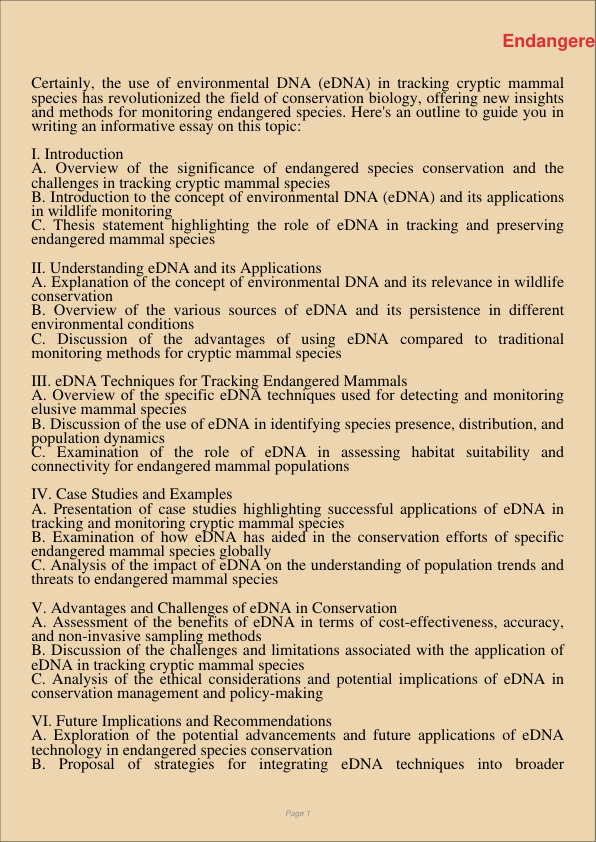Endangered Species The Use Of Environmental Dna In Tracking Cryptic Mammal Species
Jan 7, 2024
tracking cryptic mammal species
endangered species
Macro & Microeconomics
Business
Certainly, the use of environmental DNA (eDNA) in tracking cryptic mammal species has revolutionized the field of conservation biology, offering new insights and methods for monitoring endangered species. Here’s an outline to guide you in writing an informative essay on this topic:
I. Introduction A. Overview of the significance of endangered species conservation and the challenges in tracking cryptic mammal species B. Introduction to the concept of environmental DNA (eDNA) and its applications in wildlife monitoring C. Thesis statement highlighting the role of eDNA in tracking and preserving endangered mammal species
II. Understanding eDNA and its Applications A. Explanation of the concept of environmental DNA and its relevance in wildlife conservation B. Overview of the various sources of eDNA and its persistence in different environmental conditions C. Discussion of the advantages of using eDNA compared to traditional monitoring methods for cryptic mammal species
III. eDNA Techniques for Tracking Endangered Mammals A. Overview of the specific eDNA techniques used for detecting and monitoring elusive mammal species B. Discussion of the use of eDNA in identifying species presence, distribution, and population dynamics C. Examination of the role of eDNA in assessing habitat suitability and connectivity for endangered mammal populations
IV. Case Studies and Examples A. Presentation of case studies highlighting successful applications of eDNA in tracking and monitoring cryptic mammal species B. Examination of how eDNA has aided in the conservation efforts of specific endangered mammal species globally C. Analysis of the impact of eDNA on the understanding of population trends and threats to endangered mammal species
V. Advantages and Challenges of eDNA in Conservation A. Assessment of the benefits of eDNA in terms of cost-effectiveness, accuracy, and non-invasive sampling methods B. Discussion of the challenges and limitations associated with the application of eDNA in tracking cryptic mammal species C. Analysis of the ethical considerations and potential implications of eDNA in conservation management and policy-making
VI. Future Implications and Recommendations A. Exploration of the potential advancements and future applications of eDNA technology in endangered species conservation B. Proposal of strategies for integrating eDNA techniques into broader conservation and management plans for cryptic mammal species C. Recommendations for further research and development to enhance the efficacy and applicability of eDNA in wildlife monitoring and conservation
VII. Conclusion A. Summary of the key points discussed in the essay regarding the use of eDNA in tracking endangered mammal species B. Emphasis on the transformative potential of eDNA technology in shaping the future of conservation biology C. Call to action for continued support and investment in eDNA research to safeguard endangered mammal species and their habitats
Ensure that you support your arguments with current scientific research, case studies, and relevant literature to provide a comprehensive understanding of the significance of eDNA in tracking and conserving cryptic mammal species.
